When you first see your relative in the critical care unit they may have a lot of equipment around their bed. The critical care staff are very used to all of the stuff around the bed and they know that the equipment is there to help your relative. Most other people will not be familiar with any of the equipment and for this reason it can all feel quite frightening and intimidating.
Even if you know that the equipment is there to help your relative it can still be frightening. We hope you will feel more comfortable around the equipment if we can explain what it’s all for. Remember that all the equipment is there to help your relative.
Alarms
All of the equipment and machines have alarms. These will be going off a lot of the time. These alarms can be very upsetting for patients and relatives particularly when the staff don’t seem to be responding to them. The machines have to have alarms because sometimes they have problems that have to be responded to and without the alarms staff would not be able to identify these problems. Most of the time the alarms are not important and the staff will know why they are going off and that they do not require action, this apparent lack of action can be upsetting.
Sometimes the alarms are going off for good reason and the staff may have to respond quickly to these alarms. For this reason the alarms have to be left on day and night and this is one of the many reasons why patients find it difficult to get a good night’s sleep. We offer patients ear plugs to help with this but most patients don’t like them. If your relative is unhappy with the noise of the alarms at night, suggest to them and the staff that they try the ear pugs!
If you are worried about an alarm and you think there is any chance that the staff haven’t heard the alarm then let one of the staff know. Even if it’s not important we really would not want you to be sitting worrying about it and if it’s important then we would need to know about it!
Monitors
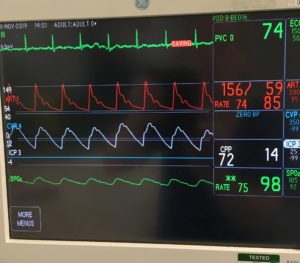
All of the patients are attached to a monitor when they are first admitted. The monitor collects information from the ECG leads and some of the tubes and lines that are in the patient.
This allows the monitor to display the heart trace, a trance of the pulse and blood oxygen levels as well as the blood pressure and other pressures including, in some patients with brain problems, the pressure inside the skull
Try not to look at each change in these measurements, they may go up and down a lot and often alarm for reasons that are acutely not important.
Ventilators (Breathing machines)
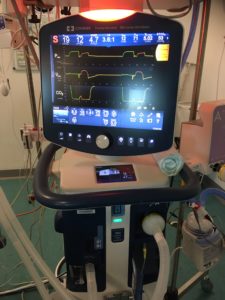
The ventilator takes over the work of breathing for many patients. This may be because their lungs aren’t working as they should or there may be problems with the way the brain is telling the lungs to breath or there may be a problem with the breathing muscles. The ventilator basically pushes air and oxygen into the lungs. They are very sophisticated machines that cost thousands of pounds. This is because they can also sense when the patient is trying to breath and can help the patient by giving an extra push to the air going in. Very sick patients are wholly ventilated by the ventilator, when they start to get better we then allow the patient to do some breathing with the ventilator helping. If a patient is fully ventilated the waves on the screen will be green and there will be a green ‘C’ (for controlled) on the top left. As the patient starts to breath the wave will become brown and yellow and the C will change to a brown ‘S’ (for spontaneous). The process of getting patients off the ventilator and back to breathing normally again is called WEANING. This may take minutes but will often take days or weeks depending on the patient’s condition. Weaning often has many steps backwards as well as forwards.
CPAP machine or flow generator
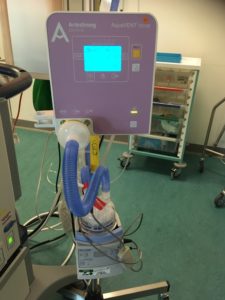
The Armstrong medical flow generator can either provide added oxygen for the patient to breath or it can provide a type of help with breathing called CPAP or continuous positive airway pressure. Critically ill patients have a tendency to collapse their lungs and the CPAP helps breathing by holding the lungs open. CPAP is used as a treatment to try and avoid full ventilation or as part of the process of weaning from a ventilator. If used for weaning the patient may have periods of breathing on CPAP and periods on the ventilator.
Syringe pumps
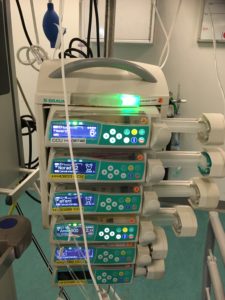
Critically ill patients often need lots of medicines and drugs to help them better. Sometimes they need to be given continuously as an ‘infusion’ into a vein and for this job we use syringe pumps. A patient may be connected to five or six pumps and sometime more. The pumps commonly contain sedative and pain relieving drugs and drugs to control the blood pressure and heart rate. Many patients also require insulin even if they are not normally diabetic. The need for insulin then often goes away again when the patient gets better. When the patient needs a lot of syringe pumps they are held in a stacker as shown here.
Other pumps
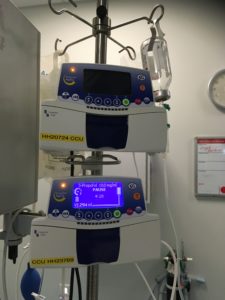
There are normally other pumps around the bed, these may include volumetric pumps as shown in the picture. These are normally used to give fluids. Fluids may be needed because the patient is unable to drink or they are losing fluids. The volumetric pumps are also used to give some medications.
Other pumps include feeding pumps. If a patient is unable to eat then they are normally given nutrition (feeding) using a feeding pump connected to a tube that goes through the nose into the stomach. This is called a nasogastric or NG tube. If patients can’t be fed into their stomach they may be fed directly into a vein using a volumetric pump.
The Heamofilter (Kidney) machine
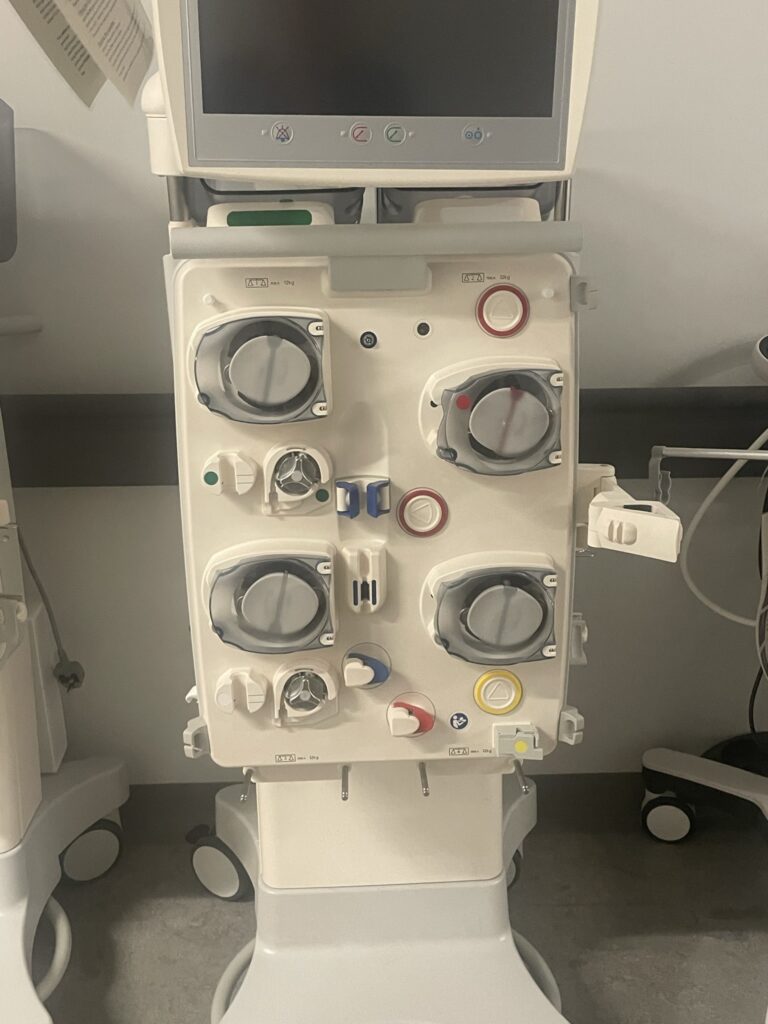
The hameofilter machine is a type of kidney machine that is commonly used on the critical care unit. It takes a continuous supply of blood from the patient and removes fluid from the blood to replace this with fresh fluid. This purifies the blood in a way similar to the way the kidney works and the heamofilter is a type of kidney machine. Patients are put on this because their kidneys are not working properly. This may be as a result of some chronic problem or the patient may have an acute kidney injury caused by their critical illness. This acute kidney injury will normally, but not always, recover in the weeks after critical illness. Patients with long term kidney problems may well have been on a dialysis machine every few days before they were critically ill. The dialysis machine is different type of kidney machine, which is also sometimes used in the critical care unit. If a patient’s acute kidney injury becomes chronic after they have left the critical care unit they they may require ongoing dialysis. This is unusual as most patients who survive recover their kidney function after an acute kidney injury.
The Volume View
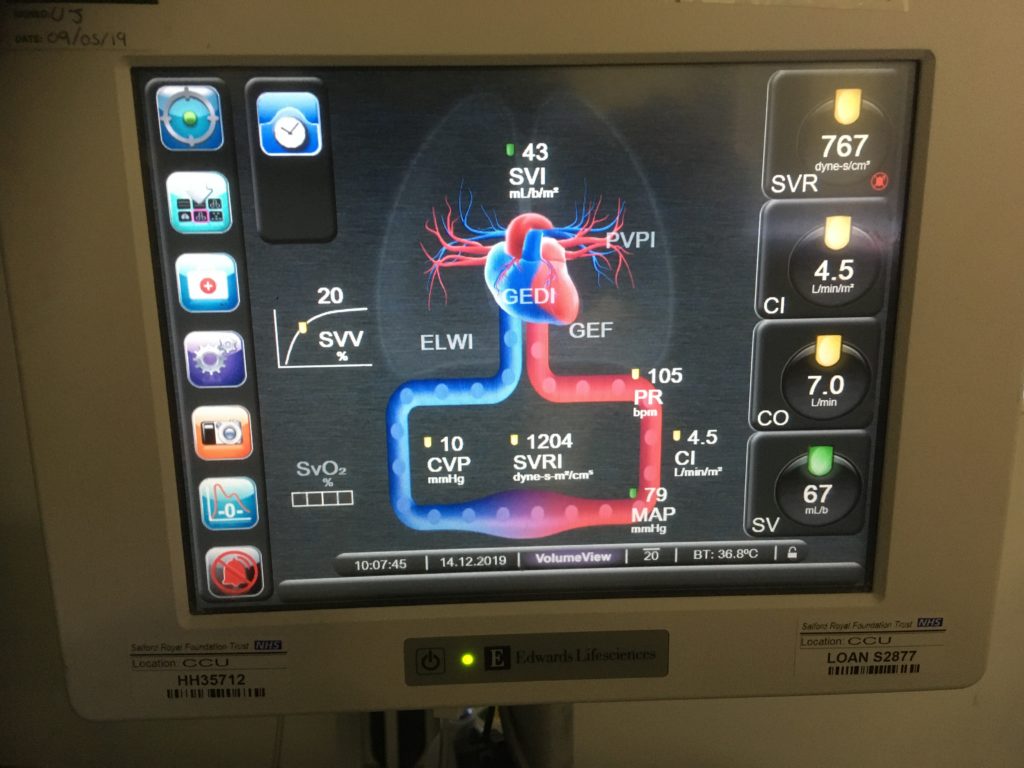
The volume view makes measurements of how the heart and blood vessels are working. This helps us in deciding how to give drugs to stimulate the heart of constrict or relax blood vessels and it helps guide the amount of fluid we give to patients.
The Doppler Monitor
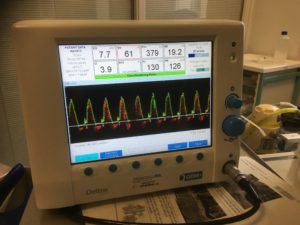
The Doppler monitor uses a special tube that goes through the patient’s mouth into the oesophagus (gullet) where it sits behind the patient’s aorta (the large artery that comes out of the heart). The tube sends out sound waves that are reflected back by the moving blood. This allows the machine to provide us with information about how the heart is working and the amount of fluid in blood vessels.